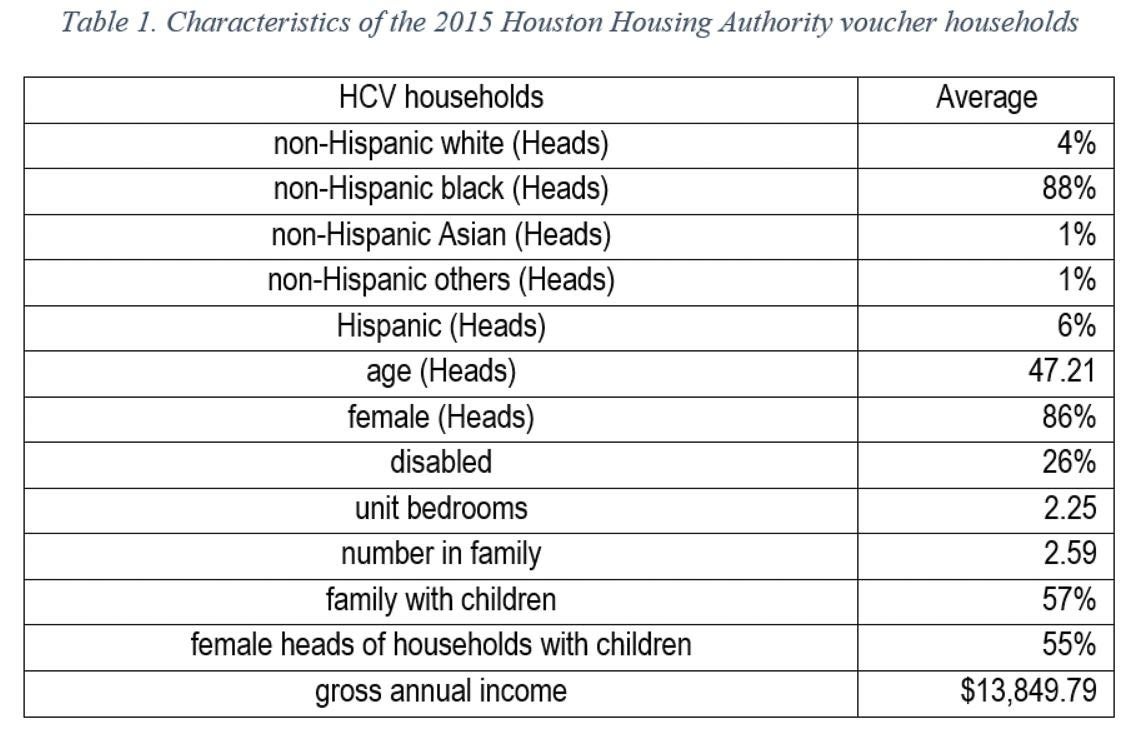In our report, Housing Choice Voucher Mobility in Harris County, we assessed how the program is related to voucher families’ location selection in Harris County, Texas.

Figure 1: The number of HCV families in Census Block Groups in 2017. Source: Kinder Institute
We analyzed the home address locations of the voucher holders subsidized by the Houston Housing Authority in 2015, 2016 and 2017. During this research period, a higher number of voucher families moved out of gentrifying neighborhoods, as defined by another Kinder report, than into gentrifying neighborhoods. Similarly, a larger number of voucher families moved out of flood-risk areas, as defined by a Greater Houston Flood Mitigation Consortium report that the Kinder Institute co-authored, than into flood-risk areas.
Our findings indicate the voucher program helps recipients with a voucher subsidy if they move. When voucher families moved, their new home charged a higher rent than their previous home. Residents in the post-move census block groups had, on average, a higher median income than those in the pre-move census block groups. Additionally, the maximum subsidy, which varies by ZIP code, was greater after moving.
The voucher program is one of the largest affordable housing programs in the country and helps some of the area’s most vulnerable populations. In the Houston area, this program helps approximately 17,000 families. About 75% are extremely low-income families who make less than 30% of the Houston area’s median family income. Voucher families, on average, make slightly more than $1,000 monthly. Houston’s voucher recipients are 88% non-Hispanic black, 86% female-headed households, 55% female-headed families with children and 26% families with disability.

Source: Kinder Institute
Voucher families spend 30% of their family income for rent. The rest of the rent is covered by the voucher subsidy from a local housing authority, as long as rental homes meet the minimum standard of housing quality by the U.S. Department of Housing and Urban Development (HUD) and contract rent does not exceed the maximum payment standard that is associated with a ZIP code.
We also assessed that voucher movers accounted for approximately 10% of the voucher recipients every year. Most voucher renters stayed in the same residence, rather than moving, even though their rent, voucher subsidy amount, and maximum subsidy associated with a ZIP code were lower than the pre-move conditions of the voucher movers.
The moving distance of Houston’s voucher movers was also limited, with approximately 50% moving within 5 miles and about 70% moving within 10 miles. The moving distances are not substantial, given that the size of Harris County is 1,777 square miles, which is larger than the state of Rhode Island. The voucher program does not radically change all voucher recipients’ residential environments, although we found some evidence that the voucher program could help move people to greater opportunity areas once they move.
Whether or not to move to another neighborhood is a difficult decision for families because there are many factors to consider, including employment, safety, transportation, education and attachment to neighborhoods. Therefore, it is important for the HHA and other local housing authorities to continue to work on providing public information such as flood risk, gentrification and neighborhood counseling to voucher recipients.
As we saw in the Moving to Opportunity for Fair Housing pilot experiment, voucher recipients could take full advantage of living in neighborhoods that potentially offer greater opportunities when solid assistance, such as housing and neighborhood counseling, is provided. Education quality and a larger subsidy amount for bigger families mattered to Houston’s voucher mobility.
To help, local housing authorities might need to focus more on certain types of families that tend to move more than others. For Houston, according to our research, this means helping people with children or larger-sized families to move, as families tend to move to neighborhoods with better opportunities for their children. To maximize the benefit of mobility this tenant-based affordable housing program offers, with the continuation of actively tailored assistance by local housing authorities, more of Houston’s voucher recipients may be able to access greater opportunity.

